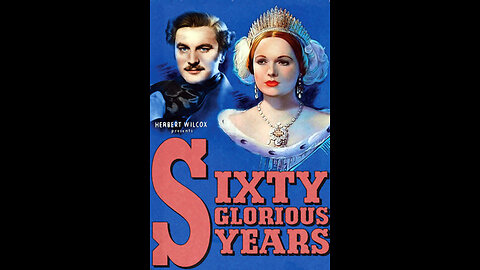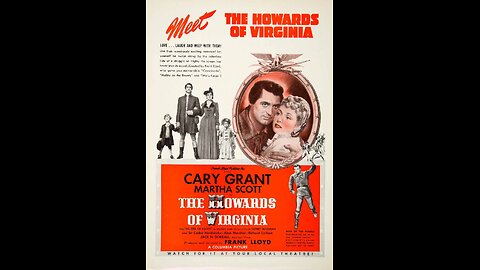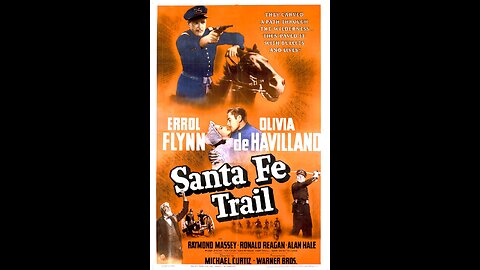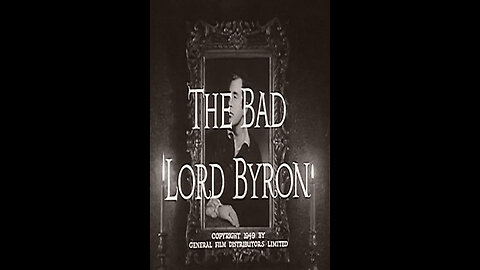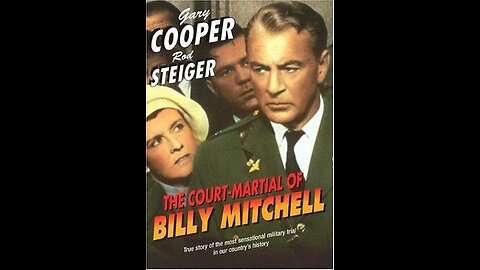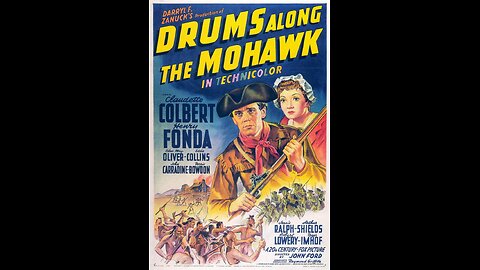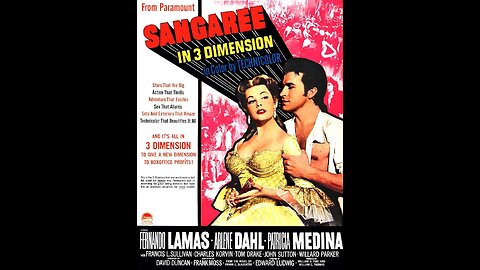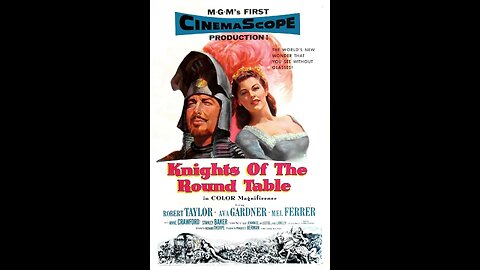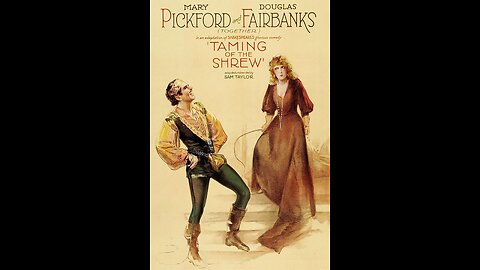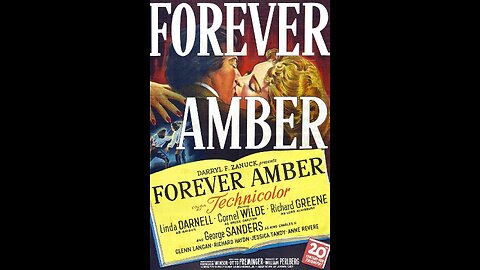
Historical Classics
56 videos
Updated 1 day ago
The Best Historical Classics from the Golden Age of FIlm
-
Forever Amber (1947) | Directed by Otto Preminger
 Classic Films & Movies ArchiveA lavish historical drama set in 17th-century England, following the rise of Amber St. Clare, an ambitious young woman who escapes poverty and uses her beauty, charm, and cunning to ascend through society. Against the backdrop of plague, political intrigue, and the Great Fire of London, Amber’s turbulent romantic pursuit of the man she truly loves shapes her dramatic journey. Genre: Historical drama / Romance Director: Otto Preminger Otto Preminger was an Austrian-American filmmaker known for his bold storytelling, interest in controversial themes, and polished visual style. After emigrating from Europe, he became a prominent director in Hollywood’s studio era, earning acclaim for films that challenged censorship and tackled complex psychological and social issues. His career spanned several decades, producing notable classics across drama, noir, and romance. Star Cast: Linda Darnell as Amber St. Clare Cornel Wilde as Bruce Carlton Richard Greene as Lord Rex Morgan George Sanders as King Charles II Glenn Langan as Sir Thomas Dudley Jessica Tandy as Nan Anne Revere as Mrs. Spong John Russell as Black Jack Mallard Natalie Schafer as Madame Sophie Margaret Wycherly as Mrs. Abbott The film drew widespread attention for its extravagant production values, lush Technicolor photography, and glamorous depiction of Restoration England. It was a major box-office success despite facing criticism from some reviewers who felt it softened or sanitized the more provocative elements of the bestselling novel. Audiences embraced Linda Darnell’s performance and the film’s sweeping sense of spectacle, even as moral guardians of the period objected to its themes of ambition, seduction, and scandal. Fun Facts: The film was adapted from Kathleen Winsor’s bestselling novel, which had been controversial and heavily censored upon release. Vincent Price was originally cast in a major role but withdrew after disagreements over production delays and recasting. Peggy Cummins was initially chosen to play Amber but was replaced after extensive footage had already been shot, leading to costly reshoots. The production involved massive sets, elaborate period costumes, and large crowd scenes, making it one of Fox’s most expensive films of the 1940s. The Great Fire of London sequence became one of the standout visual highlights of the studio’s Technicolor work at the time. * This Rumble Movie Channel is comprehensively indexed on https://kinoquick.com - find you favourite movies fast & free! * Follow this channel to be notified of daily movie updates.148 views
Classic Films & Movies ArchiveA lavish historical drama set in 17th-century England, following the rise of Amber St. Clare, an ambitious young woman who escapes poverty and uses her beauty, charm, and cunning to ascend through society. Against the backdrop of plague, political intrigue, and the Great Fire of London, Amber’s turbulent romantic pursuit of the man she truly loves shapes her dramatic journey. Genre: Historical drama / Romance Director: Otto Preminger Otto Preminger was an Austrian-American filmmaker known for his bold storytelling, interest in controversial themes, and polished visual style. After emigrating from Europe, he became a prominent director in Hollywood’s studio era, earning acclaim for films that challenged censorship and tackled complex psychological and social issues. His career spanned several decades, producing notable classics across drama, noir, and romance. Star Cast: Linda Darnell as Amber St. Clare Cornel Wilde as Bruce Carlton Richard Greene as Lord Rex Morgan George Sanders as King Charles II Glenn Langan as Sir Thomas Dudley Jessica Tandy as Nan Anne Revere as Mrs. Spong John Russell as Black Jack Mallard Natalie Schafer as Madame Sophie Margaret Wycherly as Mrs. Abbott The film drew widespread attention for its extravagant production values, lush Technicolor photography, and glamorous depiction of Restoration England. It was a major box-office success despite facing criticism from some reviewers who felt it softened or sanitized the more provocative elements of the bestselling novel. Audiences embraced Linda Darnell’s performance and the film’s sweeping sense of spectacle, even as moral guardians of the period objected to its themes of ambition, seduction, and scandal. Fun Facts: The film was adapted from Kathleen Winsor’s bestselling novel, which had been controversial and heavily censored upon release. Vincent Price was originally cast in a major role but withdrew after disagreements over production delays and recasting. Peggy Cummins was initially chosen to play Amber but was replaced after extensive footage had already been shot, leading to costly reshoots. The production involved massive sets, elaborate period costumes, and large crowd scenes, making it one of Fox’s most expensive films of the 1940s. The Great Fire of London sequence became one of the standout visual highlights of the studio’s Technicolor work at the time. * This Rumble Movie Channel is comprehensively indexed on https://kinoquick.com - find you favourite movies fast & free! * Follow this channel to be notified of daily movie updates.148 views -
Sixty Glorious Years (1938) | Directed by Herbert Wilcox
 Classic Films & Movies ArchiveSixty Glorious Years is a British historical drama that celebrates the reign of Queen Victoria, following her life from her accession to the throne through her marriage to Prince Albert and their years together until his untimely death. The film provides a sweeping and romanticized portrayal of the Victorian era, capturing the monarch’s devotion to duty, family, and her people, while also reflecting the social and political milestones of her reign. It was made as a companion piece to the earlier film Victoria the Great (1937), with much of the same cast and style, using vibrant Technicolor to heighten its grandeur. Genre: Historical drama / Biographical Director: Herbert Wilcox Herbert Wilcox (1890–1977) was a prolific English film producer and director known for his contributions to British cinema from the 1920s through the 1950s. He was one of the most successful filmmakers of his era, particularly noted for his collaborations with actress Anna Neagle, who also became his wife. Wilcox specialized in historical dramas and patriotic films that celebrated British heritage and identity, helping shape the tone of British cinema before and during World War II. Star Cast: Anna Neagle as Queen Victoria Anton Walbrook as Prince Albert C. Aubrey Smith as Duke of Wellington Walter Rilla as Prince Ernest Felix Aylmer as Lord Palmerston Lewis Casson as Lord Melbourne Fay Compton as Lady Jocelyn Charles Carson as Sir Robert Peel The film was well received in Britain, particularly for its respectful and grand depiction of Queen Victoria’s reign. Critics praised the use of Technicolor, which was still relatively rare at the time, for bringing an added sense of spectacle and pageantry. Anna Neagle’s performance as Victoria was widely acclaimed for its grace and emotional sincerity. Although the film was seen primarily as a patriotic tribute rather than a daring drama, it resonated strongly with audiences in the pre-war period, reinforcing a sense of national pride. Fun Facts: The film was shot entirely in Technicolor, one of the earliest British productions to do so. It served as a sequel to Victoria the Great (1937), continuing the story with the same lead actors. Anna Neagle spent months studying portraits and historical documents to accurately portray Queen Victoria’s mannerisms. The film premiered at London’s Leicester Square Theatre, attended by members of the royal family. Herbert Wilcox and Anna Neagle married a few years later, becoming one of British cinema’s most successful creative partnerships. Some costumes and props were authentic Victorian-era items borrowed from museums and private collections. * This Rumble Movie Channel is comprehensively indexed on https://kinoquick.com - find you favourite movies fast & free! * Follow this channel to be notified of daily movie updates.117 views
Classic Films & Movies ArchiveSixty Glorious Years is a British historical drama that celebrates the reign of Queen Victoria, following her life from her accession to the throne through her marriage to Prince Albert and their years together until his untimely death. The film provides a sweeping and romanticized portrayal of the Victorian era, capturing the monarch’s devotion to duty, family, and her people, while also reflecting the social and political milestones of her reign. It was made as a companion piece to the earlier film Victoria the Great (1937), with much of the same cast and style, using vibrant Technicolor to heighten its grandeur. Genre: Historical drama / Biographical Director: Herbert Wilcox Herbert Wilcox (1890–1977) was a prolific English film producer and director known for his contributions to British cinema from the 1920s through the 1950s. He was one of the most successful filmmakers of his era, particularly noted for his collaborations with actress Anna Neagle, who also became his wife. Wilcox specialized in historical dramas and patriotic films that celebrated British heritage and identity, helping shape the tone of British cinema before and during World War II. Star Cast: Anna Neagle as Queen Victoria Anton Walbrook as Prince Albert C. Aubrey Smith as Duke of Wellington Walter Rilla as Prince Ernest Felix Aylmer as Lord Palmerston Lewis Casson as Lord Melbourne Fay Compton as Lady Jocelyn Charles Carson as Sir Robert Peel The film was well received in Britain, particularly for its respectful and grand depiction of Queen Victoria’s reign. Critics praised the use of Technicolor, which was still relatively rare at the time, for bringing an added sense of spectacle and pageantry. Anna Neagle’s performance as Victoria was widely acclaimed for its grace and emotional sincerity. Although the film was seen primarily as a patriotic tribute rather than a daring drama, it resonated strongly with audiences in the pre-war period, reinforcing a sense of national pride. Fun Facts: The film was shot entirely in Technicolor, one of the earliest British productions to do so. It served as a sequel to Victoria the Great (1937), continuing the story with the same lead actors. Anna Neagle spent months studying portraits and historical documents to accurately portray Queen Victoria’s mannerisms. The film premiered at London’s Leicester Square Theatre, attended by members of the royal family. Herbert Wilcox and Anna Neagle married a few years later, becoming one of British cinema’s most successful creative partnerships. Some costumes and props were authentic Victorian-era items borrowed from museums and private collections. * This Rumble Movie Channel is comprehensively indexed on https://kinoquick.com - find you favourite movies fast & free! * Follow this channel to be notified of daily movie updates.117 views -
The Howards of Virginia (1940) | Directed by Frank Lloyd
 Classic Films & Movies ArchiveThe Howards of Virginia is an American historical drama that traces the life of a rugged Virginian frontiersman, Matt Howard, who becomes swept up in the events leading to the American Revolution. The film follows his rise from humble beginnings to his involvement in the struggle for independence, juxtaposed with his marriage to Jane Peyton, a woman from an aristocratic family. Through personal and political conflict, the film explores the birth of a nation and the clash between class, ideals, and freedom. Genre: Historical Drama, War, Romance Director: Frank Lloyd Frank Lloyd (1886–1960) was a Scottish-born American film director, screenwriter, and producer, and one of the most respected figures of early Hollywood. A founding member of the Academy of Motion Picture Arts and Sciences, Lloyd directed numerous silent and sound films across various genres. He won two Academy Awards for Best Director—for The Divine Lady (1929) and Cavalcade (1933)—and was nominated several times more. Known for his sweeping historical dramas and humanistic storytelling, Lloyd’s craftsmanship helped shape Hollywood’s Golden Age. Star Cast: Cary Grant as Matt Howard Martha Scott as Jane Peyton Howard Cedric Hardwicke as Fleetwood Peyton Alan Marshal as Roger Peyton Richard Carlson as Thomas Jefferson Irving Bacon as Tom Norton Paul Kelly as Benjamin Franklin Elizabeth Risdon as Mrs. Norton Montagu Love as Patrick Henry Upon its release, The Howards of Virginia received moderate critical acclaim for its ambition and historical sweep. Critics praised its patriotic spirit and the performances of Cary Grant and Martha Scott, though some found the film uneven and overly sentimental. Audiences appreciated its blend of adventure, romance, and early American history, particularly as it was released at a time when the United States was on the brink of entering World War II. The film served as a timely reminder of democratic values and national unity. Fun Facts: The film was adapted from Elizabeth Page’s novel “The Tree of Liberty.” This was one of Cary Grant’s rare forays into historical drama; he was more widely known for his contemporary comedies and thrillers. Martha Scott’s performance earned strong reviews and helped solidify her transition from stage to screen after her debut in Our Town (1940). The film’s production design sought to authentically recreate 18th-century Virginia, including colonial interiors and costuming. Frank Lloyd, himself an immigrant, was drawn to the story’s themes of liberty and equality during a time of global conflict. Richard Carlson’s portrayal of Thomas Jefferson marked one of his earliest film roles before becoming a familiar figure in 1950s cinema. The Howards of Virginia was one of the first Columbia Pictures productions to be shot with a large-scale historical scope, paving the way for later patriotic dramas. * This Rumble Movie Channel is comprehensively indexed on https://kinoquick.com - find you favourite movies fast & free! * Follow this channel to be notified of daily movie updates.329 views
Classic Films & Movies ArchiveThe Howards of Virginia is an American historical drama that traces the life of a rugged Virginian frontiersman, Matt Howard, who becomes swept up in the events leading to the American Revolution. The film follows his rise from humble beginnings to his involvement in the struggle for independence, juxtaposed with his marriage to Jane Peyton, a woman from an aristocratic family. Through personal and political conflict, the film explores the birth of a nation and the clash between class, ideals, and freedom. Genre: Historical Drama, War, Romance Director: Frank Lloyd Frank Lloyd (1886–1960) was a Scottish-born American film director, screenwriter, and producer, and one of the most respected figures of early Hollywood. A founding member of the Academy of Motion Picture Arts and Sciences, Lloyd directed numerous silent and sound films across various genres. He won two Academy Awards for Best Director—for The Divine Lady (1929) and Cavalcade (1933)—and was nominated several times more. Known for his sweeping historical dramas and humanistic storytelling, Lloyd’s craftsmanship helped shape Hollywood’s Golden Age. Star Cast: Cary Grant as Matt Howard Martha Scott as Jane Peyton Howard Cedric Hardwicke as Fleetwood Peyton Alan Marshal as Roger Peyton Richard Carlson as Thomas Jefferson Irving Bacon as Tom Norton Paul Kelly as Benjamin Franklin Elizabeth Risdon as Mrs. Norton Montagu Love as Patrick Henry Upon its release, The Howards of Virginia received moderate critical acclaim for its ambition and historical sweep. Critics praised its patriotic spirit and the performances of Cary Grant and Martha Scott, though some found the film uneven and overly sentimental. Audiences appreciated its blend of adventure, romance, and early American history, particularly as it was released at a time when the United States was on the brink of entering World War II. The film served as a timely reminder of democratic values and national unity. Fun Facts: The film was adapted from Elizabeth Page’s novel “The Tree of Liberty.” This was one of Cary Grant’s rare forays into historical drama; he was more widely known for his contemporary comedies and thrillers. Martha Scott’s performance earned strong reviews and helped solidify her transition from stage to screen after her debut in Our Town (1940). The film’s production design sought to authentically recreate 18th-century Virginia, including colonial interiors and costuming. Frank Lloyd, himself an immigrant, was drawn to the story’s themes of liberty and equality during a time of global conflict. Richard Carlson’s portrayal of Thomas Jefferson marked one of his earliest film roles before becoming a familiar figure in 1950s cinema. The Howards of Virginia was one of the first Columbia Pictures productions to be shot with a large-scale historical scope, paving the way for later patriotic dramas. * This Rumble Movie Channel is comprehensively indexed on https://kinoquick.com - find you favourite movies fast & free! * Follow this channel to be notified of daily movie updates.329 views -
Santa Fe Trail (1940) | Directed by Michael Curtiz
 Classic Films & Movies ArchiveSanta Fe Trail is a historical Western drama that dramatizes events leading up to the American Civil War. The story follows U.S. Army officers Jeb Stuart and George Custer as they are stationed at Fort Leavenworth, tasked with dealing with the abolitionist John Brown. While exploring duty, loyalty, and romance, the film weaves together fictionalized adventures with real historical figures. Genre: Western / Historical Drama Director: Michael Curtiz Michael Curtiz (1886–1962) was a Hungarian-born American film director who became one of Warner Bros.’ most prolific and successful filmmakers. Known for his versatility and craftsmanship, Curtiz directed classics across many genres, including Casablanca (1942), Captain Blood (1935), and The Adventures of Robin Hood (1938). He was recognized for his dynamic visual style and ability to handle large ensemble casts. Star Cast: Errol Flynn as J.E.B. Stuart Olivia de Havilland as Kit Carson Holliday Raymond Massey as John Brown Ronald Reagan as George Armstrong Custer Alan Hale as Tex Bell Van Heflin as Rader Gene Reynolds as Jason Brown Henry O’Neill as Cyrus K. Holliday Santa Fe Trail was well received by audiences in 1940, especially for its star power, with Errol Flynn and Olivia de Havilland reuniting in another Warner Bros. production. Ronald Reagan’s role as George Custer was notable, though smaller compared to Flynn’s leading part. Critics of later decades have noted the film’s historical inaccuracies and oversimplified depiction of John Brown, but at the time, it was considered entertaining and engaging. Fun Facts: Ronald Reagan’s portrayal of George Armstrong Custer was one of his more prominent supporting roles before his later career shift into politics. The film reunited Errol Flynn and Olivia de Havilland, who starred together in multiple Warner Bros. hits. Director Michael Curtiz was simultaneously working on other major productions for Warner Bros., showcasing his prolific output. The movie has been criticized for its historical liberties, particularly in the portrayal of John Brown and the events leading to the Civil War. Despite being set in Kansas, much of the film was shot in California. * This Rumble Movie Channel is comprehensively indexed on https://kinoquick.com - find you favourite movies fast & free! * Follow this channel to be notified of daily movie updates.250 views
Classic Films & Movies ArchiveSanta Fe Trail is a historical Western drama that dramatizes events leading up to the American Civil War. The story follows U.S. Army officers Jeb Stuart and George Custer as they are stationed at Fort Leavenworth, tasked with dealing with the abolitionist John Brown. While exploring duty, loyalty, and romance, the film weaves together fictionalized adventures with real historical figures. Genre: Western / Historical Drama Director: Michael Curtiz Michael Curtiz (1886–1962) was a Hungarian-born American film director who became one of Warner Bros.’ most prolific and successful filmmakers. Known for his versatility and craftsmanship, Curtiz directed classics across many genres, including Casablanca (1942), Captain Blood (1935), and The Adventures of Robin Hood (1938). He was recognized for his dynamic visual style and ability to handle large ensemble casts. Star Cast: Errol Flynn as J.E.B. Stuart Olivia de Havilland as Kit Carson Holliday Raymond Massey as John Brown Ronald Reagan as George Armstrong Custer Alan Hale as Tex Bell Van Heflin as Rader Gene Reynolds as Jason Brown Henry O’Neill as Cyrus K. Holliday Santa Fe Trail was well received by audiences in 1940, especially for its star power, with Errol Flynn and Olivia de Havilland reuniting in another Warner Bros. production. Ronald Reagan’s role as George Custer was notable, though smaller compared to Flynn’s leading part. Critics of later decades have noted the film’s historical inaccuracies and oversimplified depiction of John Brown, but at the time, it was considered entertaining and engaging. Fun Facts: Ronald Reagan’s portrayal of George Armstrong Custer was one of his more prominent supporting roles before his later career shift into politics. The film reunited Errol Flynn and Olivia de Havilland, who starred together in multiple Warner Bros. hits. Director Michael Curtiz was simultaneously working on other major productions for Warner Bros., showcasing his prolific output. The movie has been criticized for its historical liberties, particularly in the portrayal of John Brown and the events leading to the Civil War. Despite being set in Kansas, much of the film was shot in California. * This Rumble Movie Channel is comprehensively indexed on https://kinoquick.com - find you favourite movies fast & free! * Follow this channel to be notified of daily movie updates.250 views -
The Bad Lord Byron (1949) | Directed by David MacDonald
 Classic Films & Movies ArchiveThis British historical drama presents a romanticized and tragic account of the life of poet Lord George Gordon Byron. The film recounts Byron’s passionate affairs, political scandals, and eventual self-imposed exile, told through a mix of courtroom sequences and flashbacks. It seeks to capture both the brilliance of his poetry and the turbulence of his private life. Genre: Historical Drama / Biopic Director: David MacDonald David MacDonald was a Scottish-born director who worked in British cinema from the 1930s through the 1950s. He directed a range of films, from war propaganda such as Desert Victory (1943), which won an Academy Award for Best Documentary, to dramas and thrillers. Though never considered among Britain’s top-tier directors, he was known for solid craftsmanship and bringing a degree of visual flair to his projects. Star Cast: Dennis Price as Lord Byron Mai Zetterling as Teresa Guiccioli Joan Greenwood as Lady Caroline Lamb Linden Travers as Augusta Leigh Andrew Osborn as Lord Castlereagh Hugh Dempster as Hobhouse Sonia Holm as Lady Oxford The film was not well received upon release. Critics considered it melodramatic and historically inaccurate, and audiences were largely indifferent. Its mixture of courtroom framing and flashbacks was seen as awkward, and the film failed to capture the spirit of Byron’s poetry or the complexity of his character. Over time, it has been remembered mostly as an ambitious but unsuccessful attempt at a biopic. Fun Facts: Dennis Price, best known for his later role in Kind Hearts and Coronets (1949), was cast as Byron, but many critics felt he lacked the charisma to embody the controversial poet. The film’s title was inspired by Byron’s scandalous reputation in life, though some reviewers found it too sensational. Mai Zetterling, who played Teresa Guiccioli, went on to have a successful career as both an actress and later as a director. The Bad Lord Byron is rarely screened today and is sometimes cited as an example of postwar British cinema’s struggles to create compelling costume dramas outside the Shakespearean or Dickensian tradition. Despite its failure, the film contributed to the ongoing fascination with Byron as one of literature’s most flamboyant figures. * This Rumble Movie Channel is comprehensively indexed on https://kinoquick.com - find you favourite movies fast & free! * Follow this channel to be notified of daily movie updates.387 views 1 comment
Classic Films & Movies ArchiveThis British historical drama presents a romanticized and tragic account of the life of poet Lord George Gordon Byron. The film recounts Byron’s passionate affairs, political scandals, and eventual self-imposed exile, told through a mix of courtroom sequences and flashbacks. It seeks to capture both the brilliance of his poetry and the turbulence of his private life. Genre: Historical Drama / Biopic Director: David MacDonald David MacDonald was a Scottish-born director who worked in British cinema from the 1930s through the 1950s. He directed a range of films, from war propaganda such as Desert Victory (1943), which won an Academy Award for Best Documentary, to dramas and thrillers. Though never considered among Britain’s top-tier directors, he was known for solid craftsmanship and bringing a degree of visual flair to his projects. Star Cast: Dennis Price as Lord Byron Mai Zetterling as Teresa Guiccioli Joan Greenwood as Lady Caroline Lamb Linden Travers as Augusta Leigh Andrew Osborn as Lord Castlereagh Hugh Dempster as Hobhouse Sonia Holm as Lady Oxford The film was not well received upon release. Critics considered it melodramatic and historically inaccurate, and audiences were largely indifferent. Its mixture of courtroom framing and flashbacks was seen as awkward, and the film failed to capture the spirit of Byron’s poetry or the complexity of his character. Over time, it has been remembered mostly as an ambitious but unsuccessful attempt at a biopic. Fun Facts: Dennis Price, best known for his later role in Kind Hearts and Coronets (1949), was cast as Byron, but many critics felt he lacked the charisma to embody the controversial poet. The film’s title was inspired by Byron’s scandalous reputation in life, though some reviewers found it too sensational. Mai Zetterling, who played Teresa Guiccioli, went on to have a successful career as both an actress and later as a director. The Bad Lord Byron is rarely screened today and is sometimes cited as an example of postwar British cinema’s struggles to create compelling costume dramas outside the Shakespearean or Dickensian tradition. Despite its failure, the film contributed to the ongoing fascination with Byron as one of literature’s most flamboyant figures. * This Rumble Movie Channel is comprehensively indexed on https://kinoquick.com - find you favourite movies fast & free! * Follow this channel to be notified of daily movie updates.387 views 1 comment -
The Court-Martial of Billy Mitchell (1955) | Directed by Otto Preminger
 Classic Films & Movies ArchiveThe Court-Martial of Billy Mitchell is a courtroom drama based on the true story of General Billy Mitchell, a U.S. Army officer who was court-martialled in the 1920s after criticizing military leaders for their neglect of air power. The film portrays his fight to defend his beliefs, his career, and his vision for the future of aviation. Genre: Drama, Historical, Biography Director: Otto Preminger Otto Preminger (1905–1986) was an Austrian-American director known for his bold and often controversial films. His works frequently tackled social issues and censorship, including films such as Anatomy of a Murder (1959), The Man with the Golden Arm (1955), and Laura (1944). Preminger had a reputation for strong-willed independence and was instrumental in challenging the Hollywood Production Code. Star Cast: Gary Cooper as General Billy Mitchell Charles Bickford as Major Allen Gullion Ralph Bellamy as Secretary of War Frank Reid Rod Steiger as Major Rudolf Cox Elizabeth Montgomery as Margaret Mitchell Fred Clark as Congressman Frank Oliver James Daly as Lt. Col. Joseph Moreland The film received positive attention for its serious approach to a controversial historical figure and for Gary Cooper’s strong performance in the title role. Critics praised the courtroom sequences and the film’s message about integrity and vision, though some viewed it as overly talkative. It resonated with postwar audiences who were keenly aware of the importance of air power. Fun Facts: The film was based on the true story of General Billy Mitchell, considered the “father of the U.S. Air Force.” Otto Preminger directed the film at a time when he was tackling socially relevant and challenging topics. Gary Cooper, though already a Hollywood legend, was chosen for the role because of his dignified screen presence, which fit Mitchell’s character. Elizabeth Montgomery, later famous for her role in the TV series Bewitched, made her film debut in this movie. Actual courtroom transcripts from Mitchell’s real trial were used as inspiration for the script. * This Rumble Movie Channel is comprehensively indexed on https://kinoquick.com - find you favourite movies fast & free! * Follow this channel to be notified of daily movie updates.250 views 1 comment
Classic Films & Movies ArchiveThe Court-Martial of Billy Mitchell is a courtroom drama based on the true story of General Billy Mitchell, a U.S. Army officer who was court-martialled in the 1920s after criticizing military leaders for their neglect of air power. The film portrays his fight to defend his beliefs, his career, and his vision for the future of aviation. Genre: Drama, Historical, Biography Director: Otto Preminger Otto Preminger (1905–1986) was an Austrian-American director known for his bold and often controversial films. His works frequently tackled social issues and censorship, including films such as Anatomy of a Murder (1959), The Man with the Golden Arm (1955), and Laura (1944). Preminger had a reputation for strong-willed independence and was instrumental in challenging the Hollywood Production Code. Star Cast: Gary Cooper as General Billy Mitchell Charles Bickford as Major Allen Gullion Ralph Bellamy as Secretary of War Frank Reid Rod Steiger as Major Rudolf Cox Elizabeth Montgomery as Margaret Mitchell Fred Clark as Congressman Frank Oliver James Daly as Lt. Col. Joseph Moreland The film received positive attention for its serious approach to a controversial historical figure and for Gary Cooper’s strong performance in the title role. Critics praised the courtroom sequences and the film’s message about integrity and vision, though some viewed it as overly talkative. It resonated with postwar audiences who were keenly aware of the importance of air power. Fun Facts: The film was based on the true story of General Billy Mitchell, considered the “father of the U.S. Air Force.” Otto Preminger directed the film at a time when he was tackling socially relevant and challenging topics. Gary Cooper, though already a Hollywood legend, was chosen for the role because of his dignified screen presence, which fit Mitchell’s character. Elizabeth Montgomery, later famous for her role in the TV series Bewitched, made her film debut in this movie. Actual courtroom transcripts from Mitchell’s real trial were used as inspiration for the script. * This Rumble Movie Channel is comprehensively indexed on https://kinoquick.com - find you favourite movies fast & free! * Follow this channel to be notified of daily movie updates.250 views 1 comment -
Drums Along the Mohawk (1939) | Directed by John Ford
 Classic Films & Movies ArchiveDrums Along the Mohawk is a historical drama set during the American Revolutionary War, focusing on a young couple who settle in the Mohawk Valley of New York. As they struggle to build a life on the frontier, they are caught in the violent clashes between colonists, Native Americans, and British forces. The story combines romance, hardship, and patriotism, portraying the resilience of settlers during turbulent times. Genre: Historical Drama / War Director: John Ford John Ford (1894–1973) was one of America’s most celebrated film directors, renowned for his mastery of visual storytelling and his depictions of American history and identity. With a career spanning over fifty years, he directed more than 140 films, winning four Academy Awards for Best Director. Known for works such as Stagecoach (1939), The Grapes of Wrath (1940), and The Searchers (1956), Ford developed a distinctive style that emphasized sweeping landscapes, strong characters, and moral conflicts. Star Cast: * Claudette Colbert as Lana Martin * Henry Fonda as Gilbert Martin * Edna May Oliver as Mrs. McKlennar * John Carradine as Caldwell * Dorris Bowdon as Mary Reall * Jessie Ralph as Mrs. Weaver * Arthur Shields as Reverend Rosenkrantz * Robert Lowery as John Weaver The film was both a critical and commercial success, admired for its Technicolor cinematography, strong performances, and John Ford’s direction. It was nominated for two Academy Awards, including Best Supporting Actress for Edna May Oliver and Best Cinematography. Audiences embraced the film for its patriotic themes and stirring dramatization of the hardships faced by frontier settlers during the Revolution. Fun Facts: * Drums Along the Mohawk was John Ford’s first film in Technicolor, showcasing his talent for composition in vivid color landscapes. * Edna May Oliver’s performance as the feisty frontier widow earned her an Academy Award nomination and widespread acclaim. * The film was adapted from the 1936 best-selling novel by Walter D. Edmonds, which had been a major success before its screen version. * Henry Fonda’s role as Gilbert Martin helped solidify his reputation as a versatile actor capable of embodying the American everyman. * Released the same year as Stagecoach, the film demonstrated Ford’s mastery of both historical drama and the western, solidifying his place as a leading Hollywood director. * The movie was a significant box office hit during its release, reflecting the audience’s appetite for historical adventure and patriotic storytelling on the eve of World War II. * This Rumble Movie Channel is comprehensively indexed on https://kinoquick.com - find you favourite movies fast & free! * Follow this channel to be notified of daily movie updates.244 views
Classic Films & Movies ArchiveDrums Along the Mohawk is a historical drama set during the American Revolutionary War, focusing on a young couple who settle in the Mohawk Valley of New York. As they struggle to build a life on the frontier, they are caught in the violent clashes between colonists, Native Americans, and British forces. The story combines romance, hardship, and patriotism, portraying the resilience of settlers during turbulent times. Genre: Historical Drama / War Director: John Ford John Ford (1894–1973) was one of America’s most celebrated film directors, renowned for his mastery of visual storytelling and his depictions of American history and identity. With a career spanning over fifty years, he directed more than 140 films, winning four Academy Awards for Best Director. Known for works such as Stagecoach (1939), The Grapes of Wrath (1940), and The Searchers (1956), Ford developed a distinctive style that emphasized sweeping landscapes, strong characters, and moral conflicts. Star Cast: * Claudette Colbert as Lana Martin * Henry Fonda as Gilbert Martin * Edna May Oliver as Mrs. McKlennar * John Carradine as Caldwell * Dorris Bowdon as Mary Reall * Jessie Ralph as Mrs. Weaver * Arthur Shields as Reverend Rosenkrantz * Robert Lowery as John Weaver The film was both a critical and commercial success, admired for its Technicolor cinematography, strong performances, and John Ford’s direction. It was nominated for two Academy Awards, including Best Supporting Actress for Edna May Oliver and Best Cinematography. Audiences embraced the film for its patriotic themes and stirring dramatization of the hardships faced by frontier settlers during the Revolution. Fun Facts: * Drums Along the Mohawk was John Ford’s first film in Technicolor, showcasing his talent for composition in vivid color landscapes. * Edna May Oliver’s performance as the feisty frontier widow earned her an Academy Award nomination and widespread acclaim. * The film was adapted from the 1936 best-selling novel by Walter D. Edmonds, which had been a major success before its screen version. * Henry Fonda’s role as Gilbert Martin helped solidify his reputation as a versatile actor capable of embodying the American everyman. * Released the same year as Stagecoach, the film demonstrated Ford’s mastery of both historical drama and the western, solidifying his place as a leading Hollywood director. * The movie was a significant box office hit during its release, reflecting the audience’s appetite for historical adventure and patriotic storytelling on the eve of World War II. * This Rumble Movie Channel is comprehensively indexed on https://kinoquick.com - find you favourite movies fast & free! * Follow this channel to be notified of daily movie updates.244 views -
Sangaree (1953) | Directed by Edward Ludwig
 Classic Films & Movies Archive*Sangaree* is a Technicolor historical melodrama set in post-Revolutionary War Savannah, Georgia. The story centers on Dr. Carlos Morales, a former bondservant who inherits a wealthy estate called Sangaree. His efforts to improve the lives of the underprivileged bring him into conflict with powerful elites and entangle him in a dangerous romantic and political intrigue. Genre: Historical drama, romance Director: Edward Ludwig Edward Ludwig was a Russian-born American director whose career spanned from the silent era through the 1950s. Known for his solid craftsmanship in action and adventure films, he directed features across various genres. Ludwig was not typically a high-profile auteur but reliably handled mainstream studio projects like *Sangaree* with technical polish. Star cast: * Fernando Lamas as Dr. Carlos Morales * Arlene Dahl as Nancy Darby * Patricia Medina as Martha Darby * Francis L. Sullivan as Dr. Bristol * Charles Korvin as Felix Darby * John Sutton as Roy Darby *Sangaree* was notable for being Paramount’s first film shot in 3D, though it was often screened flat in many theaters. The film was marketed as a colorful romantic epic and drew moderate box office success thanks to its star power and visual appeal, though critics found it formulaic and heavy-handed in its messaging. Fun facts: * The movie was Paramount Pictures’ inaugural foray into the 3D craze of the early 1950s, though the 3D effect was not widely utilized. * Real-life married couple Fernando Lamas and Arlene Dahl starred together, boosting public interest. * The story was based on a novel by Frank G. Slaughter, a physician turned popular historical fiction writer. * Despite its lush costumes and plantation setting, the film received mixed reviews for historical inaccuracy and melodramatic tone. * Patricia Medina’s performance as the scheming sister added a touch of camp that later appealed to cult audiences. * This Rumble Movie Channel is comprehensively indexed on https://kinoquick.com - find you favourite movies fast & free! * Follow this channel to be notified of daily movie updates.319 views
Classic Films & Movies Archive*Sangaree* is a Technicolor historical melodrama set in post-Revolutionary War Savannah, Georgia. The story centers on Dr. Carlos Morales, a former bondservant who inherits a wealthy estate called Sangaree. His efforts to improve the lives of the underprivileged bring him into conflict with powerful elites and entangle him in a dangerous romantic and political intrigue. Genre: Historical drama, romance Director: Edward Ludwig Edward Ludwig was a Russian-born American director whose career spanned from the silent era through the 1950s. Known for his solid craftsmanship in action and adventure films, he directed features across various genres. Ludwig was not typically a high-profile auteur but reliably handled mainstream studio projects like *Sangaree* with technical polish. Star cast: * Fernando Lamas as Dr. Carlos Morales * Arlene Dahl as Nancy Darby * Patricia Medina as Martha Darby * Francis L. Sullivan as Dr. Bristol * Charles Korvin as Felix Darby * John Sutton as Roy Darby *Sangaree* was notable for being Paramount’s first film shot in 3D, though it was often screened flat in many theaters. The film was marketed as a colorful romantic epic and drew moderate box office success thanks to its star power and visual appeal, though critics found it formulaic and heavy-handed in its messaging. Fun facts: * The movie was Paramount Pictures’ inaugural foray into the 3D craze of the early 1950s, though the 3D effect was not widely utilized. * Real-life married couple Fernando Lamas and Arlene Dahl starred together, boosting public interest. * The story was based on a novel by Frank G. Slaughter, a physician turned popular historical fiction writer. * Despite its lush costumes and plantation setting, the film received mixed reviews for historical inaccuracy and melodramatic tone. * Patricia Medina’s performance as the scheming sister added a touch of camp that later appealed to cult audiences. * This Rumble Movie Channel is comprehensively indexed on https://kinoquick.com - find you favourite movies fast & free! * Follow this channel to be notified of daily movie updates.319 views -
Knights of the Round Table (1953) | Directed by Richard Thorpe
 Classic Films & Movies ArchiveKnights of the Round Table is a sweeping Technicolor adventure that brings the legends of King Arthur, Sir Lancelot, and Queen Guinevere to life. Set in a mythic version of medieval Britain, the film follows Arthur’s rise to the throne, the formation of the Round Table, and the tragic love triangle that threatens to destroy his kingdom. Amid battles, court intrigue, and noble quests, the knights strive for unity and justice in a land torn by ambition and betrayal. The story blends romance, heroism, and legend in a grand spectacle of chivalric ideals. Genre: Historical adventure, fantasy Director: Richard Thorpe Richard Thorpe was an American film director known for his long and prolific career at MGM, directing over 180 films across genres. Born in 1896 in Kansas City, he began in the silent film era and built a reputation for efficiency and reliability, often completing films ahead of schedule. Though not known for a signature style, Thorpe was skilled at crafting commercially successful movies, particularly in costume dramas and musicals. His other well-known films include Ivanhoe, Jailhouse Rock, and The Prisoner of Zenda. Star cast: Robert Taylor as Sir Lancelot Ava Gardner as Queen Guinevere Mel Ferrer as King Arthur Stanley Baker as Modred Anne Crawford as Morgan Le Fay Felix Aylmer as Merlin Gabriel Woolf as Sir Percival The film was a box-office success and a visual spectacle that impressed audiences with its lush Technicolor cinematography and grand battle sequences. It was praised for its lavish production values and stirring musical score. While some critics found the storytelling somewhat stiff and melodramatic, the film’s romanticized portrayal of Arthurian legend resonated with moviegoers. It was one of MGM’s major hits of the early 1950s and was nominated for two Academy Awards, including Best Art Direction and Best Costume Design. Fun facts: * Knights of the Round Table was the first CinemaScope film produced by MGM and one of the earliest wide-screen epics, signaling a new era in visual storytelling. * The film was shot on location in England and Ireland, with authentic castles and landscapes enhancing the medieval setting. * It was MGM’s first Arthurian film and helped spark renewed interest in chivalric epics during the 1950s. * Robert Taylor had previously starred in Ivanhoe, another medieval epic directed by Richard Thorpe, making him a familiar face in period costume films. * The film was based loosely on Sir Thomas Malory’s "Le Morte d'Arthur" and took liberties with the legend to heighten drama and romantic tension. * Ava Gardner’s casting as Guinevere added star power, though her performance received mixed reviews for being more glamorous than regal. * This Rumble Movie Channel is comprehensively indexed on https://kinoquick.com - find you favourite movies fast & free! * Follow this channel to be notified of daily movie updates.353 views
Classic Films & Movies ArchiveKnights of the Round Table is a sweeping Technicolor adventure that brings the legends of King Arthur, Sir Lancelot, and Queen Guinevere to life. Set in a mythic version of medieval Britain, the film follows Arthur’s rise to the throne, the formation of the Round Table, and the tragic love triangle that threatens to destroy his kingdom. Amid battles, court intrigue, and noble quests, the knights strive for unity and justice in a land torn by ambition and betrayal. The story blends romance, heroism, and legend in a grand spectacle of chivalric ideals. Genre: Historical adventure, fantasy Director: Richard Thorpe Richard Thorpe was an American film director known for his long and prolific career at MGM, directing over 180 films across genres. Born in 1896 in Kansas City, he began in the silent film era and built a reputation for efficiency and reliability, often completing films ahead of schedule. Though not known for a signature style, Thorpe was skilled at crafting commercially successful movies, particularly in costume dramas and musicals. His other well-known films include Ivanhoe, Jailhouse Rock, and The Prisoner of Zenda. Star cast: Robert Taylor as Sir Lancelot Ava Gardner as Queen Guinevere Mel Ferrer as King Arthur Stanley Baker as Modred Anne Crawford as Morgan Le Fay Felix Aylmer as Merlin Gabriel Woolf as Sir Percival The film was a box-office success and a visual spectacle that impressed audiences with its lush Technicolor cinematography and grand battle sequences. It was praised for its lavish production values and stirring musical score. While some critics found the storytelling somewhat stiff and melodramatic, the film’s romanticized portrayal of Arthurian legend resonated with moviegoers. It was one of MGM’s major hits of the early 1950s and was nominated for two Academy Awards, including Best Art Direction and Best Costume Design. Fun facts: * Knights of the Round Table was the first CinemaScope film produced by MGM and one of the earliest wide-screen epics, signaling a new era in visual storytelling. * The film was shot on location in England and Ireland, with authentic castles and landscapes enhancing the medieval setting. * It was MGM’s first Arthurian film and helped spark renewed interest in chivalric epics during the 1950s. * Robert Taylor had previously starred in Ivanhoe, another medieval epic directed by Richard Thorpe, making him a familiar face in period costume films. * The film was based loosely on Sir Thomas Malory’s "Le Morte d'Arthur" and took liberties with the legend to heighten drama and romantic tension. * Ava Gardner’s casting as Guinevere added star power, though her performance received mixed reviews for being more glamorous than regal. * This Rumble Movie Channel is comprehensively indexed on https://kinoquick.com - find you favourite movies fast & free! * Follow this channel to be notified of daily movie updates.353 views -
The Taming of the Shrew (1929) | Directed by Sam Taylor
 Classic Films & Movies Archive"The Taming of the Shrew" is a romantic comedy adapted from William Shakespeare’s play of the same name. Set in Renaissance Italy, it tells the story of the boisterous and headstrong Katharina and her turbulent relationship with the equally fiery Petruchio, who seeks to "tame" her into a compliant wife. This 1929 film was among the earliest talkies to adapt Shakespeare for the screen, offering a theatrical and stylized interpretation with the novelty of synchronized sound. Genre: Romantic Comedy, Historical Drama, Shakespeare Adaptation Director: Sam Taylor Sam Taylor was an American film director and screenwriter known primarily for his work during the silent and early sound eras. Born in 1895, Taylor directed several successful comedies in the 1920s, often working with stars like Harold Lloyd. While not a Shakespeare specialist, Taylor was selected to helm this early sound adaptation of the Bard, notable for its high-profile cast and ambitious production. His direction emphasized theatrical flair and performance over cinematic innovation. Star Cast: * Mary Pickford as Katharina * Douglas Fairbanks as Petruchio Public Reaction: The film generated significant public interest due to the casting of Mary Pickford and Douglas Fairbanks, the most famous Hollywood couple of the silent era. However, critical reception was mixed. Audiences were fascinated by the novelty of hearing Shakespeare spoken in a motion picture, but many critics found the film’s theatrical style and stiff delivery awkward. The strained personal relationship between Pickford and Fairbanks—reflected in their performances—added a layer of fascination and tension for contemporary viewers. The film did not perform well at the box office and was considered a misstep in both stars’ careers during the transitional period from silent to sound film. Fun Facts: * It was the first feature-length Shakespeare adaptation made in the sound era and the only film in which Mary Pickford and Douglas Fairbanks appeared together. * The film was famously marketed with the line: "By William Shakespeare, with additional dialogue by Sam Taylor." * Pickford and Fairbanks were in the midst of a troubled marriage during filming, and their real-life animosity may have influenced their on-screen chemistry. * Critics at the time were divided on whether the spoken dialogue improved or hindered the film’s impact, as early sound recording technology was still primitive. * The film was considered lost for many years until a print was rediscovered and restored, offering valuable insight into early sound filmmaking and Shakespeare on screen. * This Rumble Movie Channel is comprehensively indexed on https://kinoquick.com - find you favourite movies fast & free! * Follow this channel to be notified of daily movie updates.305 views
Classic Films & Movies Archive"The Taming of the Shrew" is a romantic comedy adapted from William Shakespeare’s play of the same name. Set in Renaissance Italy, it tells the story of the boisterous and headstrong Katharina and her turbulent relationship with the equally fiery Petruchio, who seeks to "tame" her into a compliant wife. This 1929 film was among the earliest talkies to adapt Shakespeare for the screen, offering a theatrical and stylized interpretation with the novelty of synchronized sound. Genre: Romantic Comedy, Historical Drama, Shakespeare Adaptation Director: Sam Taylor Sam Taylor was an American film director and screenwriter known primarily for his work during the silent and early sound eras. Born in 1895, Taylor directed several successful comedies in the 1920s, often working with stars like Harold Lloyd. While not a Shakespeare specialist, Taylor was selected to helm this early sound adaptation of the Bard, notable for its high-profile cast and ambitious production. His direction emphasized theatrical flair and performance over cinematic innovation. Star Cast: * Mary Pickford as Katharina * Douglas Fairbanks as Petruchio Public Reaction: The film generated significant public interest due to the casting of Mary Pickford and Douglas Fairbanks, the most famous Hollywood couple of the silent era. However, critical reception was mixed. Audiences were fascinated by the novelty of hearing Shakespeare spoken in a motion picture, but many critics found the film’s theatrical style and stiff delivery awkward. The strained personal relationship between Pickford and Fairbanks—reflected in their performances—added a layer of fascination and tension for contemporary viewers. The film did not perform well at the box office and was considered a misstep in both stars’ careers during the transitional period from silent to sound film. Fun Facts: * It was the first feature-length Shakespeare adaptation made in the sound era and the only film in which Mary Pickford and Douglas Fairbanks appeared together. * The film was famously marketed with the line: "By William Shakespeare, with additional dialogue by Sam Taylor." * Pickford and Fairbanks were in the midst of a troubled marriage during filming, and their real-life animosity may have influenced their on-screen chemistry. * Critics at the time were divided on whether the spoken dialogue improved or hindered the film’s impact, as early sound recording technology was still primitive. * The film was considered lost for many years until a print was rediscovered and restored, offering valuable insight into early sound filmmaking and Shakespeare on screen. * This Rumble Movie Channel is comprehensively indexed on https://kinoquick.com - find you favourite movies fast & free! * Follow this channel to be notified of daily movie updates.305 views
